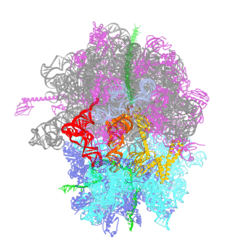Mechanisms of Translation Regulation
Translation termination is a crucial step in the translation cycle, defining the lengths of all cellular proteins. We'd like to understand how the accuracy of translation termination is achieved, preventing accumulation of prematurely released proteins, which can be toxic to the living cell. Also, we study how termination is regulated, for example by pseudouridylation of mRNA (Svidritskiy et al. "Structural Basis for Translation Termination on a Pseudouridylated Stop Codon". J. Mol. Biol. 2016). At the end of protein synthesis, release factor RF1 or RF2 (RF2 shown in yellow) binds to the bacterial 70S ribosome in response to a termination signal encoded in a messenger RNA (green) located on the small 30S ribosomal subunit (cyan and blue). RF2 is positioned to catalyze the hydrolysis of a peptidyl-tRNA (green and orange) on the large 50S subunit (grey, light purple and magenta). An E-site-bound tRNA is in red. Reviewed in Korostelev AA. "Structural aspects of translation termination on the ribosome". RNA. 2011 Aug;17(8):1409-21.
Click on the image above to see a more detailed view.
